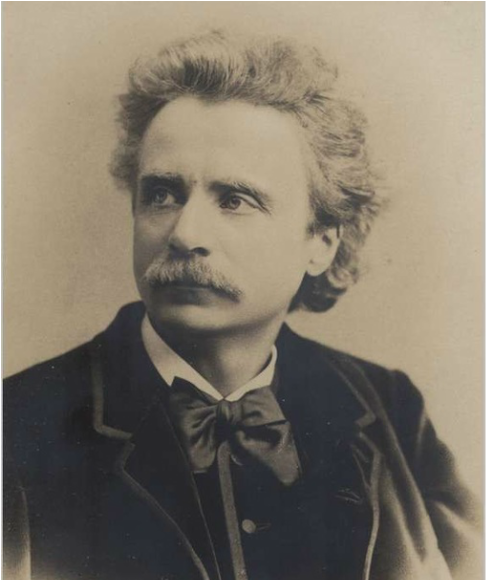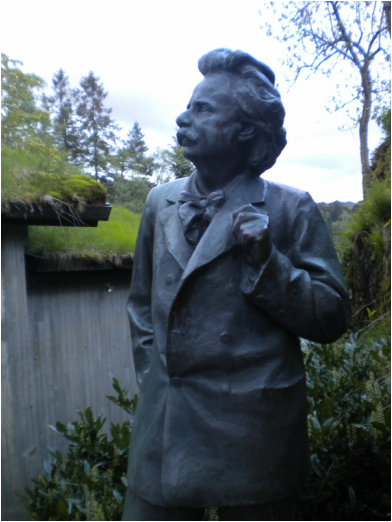Biography of Edvard Grieg (1843-1907)
|
Edvard Grieg was the first Norwegian composer to achieve international stature. A consummate master of both melody and harmony, intimately familiar with the idiosyncrasies of Norwegian folk music, he created works that struck his hearers as fresh, charming, even exotic, music that was strangely and interestingly different from anything they had heard before.
Born in the old Hanseatic port city of Bergen, Grieg had the good fortune to have a mother who was by all accounts the best pianist in town. She had studied voice, piano and music theory in Hamburg, and upon returning to Bergen had become a leading figure in local musical circles, often accompanying visiting artists. Grieg thus grew up in a house full of music, and years later, in 1903, recalled a childhood musical experience that affected him profoundly: "Why not begin by remembering the strangely mystical satisfaction of stretching my arms over the piano keyboard and bringing forth──not a melody. Far from it! No, it had to be a harmony. First a third, then a triad, then a seventh chord. And finally, both hands helping—O joy!—a ninth chord, with five tones. When I had discovered this, my rapture knew no bounds. That was a success! No later success has been able to enrapture me like this." Edvard began taking lessons from his mother not long afterwards. In 1858, Grieg enrolled at the famous Leipzig Conservatory, where the aura of Bach, Mendelssohn, and Schumann hovered like a ghostly presence over that famous "city of music." Though he later had mainly negative things to say about the training he received in Leipzig, the truth appears to be that in most respects it was just what he needed at this stage of his development. The Leipzig curriculum required that he study harmony, counterpoint, score reading and composition. After a slow start he made rapid progress as a conservatory student and earned the praise of his instructors, who included Ignaz Moscheles and Ernst Ferdinand Wenzel. Grieg also became a competent pianist during his conservatory years. In 1863, after a period of indecision about what to do next, Grieg went to Copenhagen hoping to find inspiration in the rich music life of that city. There he made the acquaintance of Danish composers J. P. E. Hartmann and Nils Gade, and the young Norwegian nationalist composer Rikard Nordraak, whose best-known composition is "Ja vi elsker dette landet” (“Yes, we love this land”), the song that later became the Norwegian national anthem. Tragically, Nordraak died of tuberculosis at the age of 27, but he is revered in Norway not least as the man whose words and example somehow inspired Grieg to tap into his own creative resources. In later years Grieg often acknowledged Nordraak’s important role in helping him find his voice as a composer. During a visit to Norway in the summer of 1864, Grieg spent several days with virtuoso violinist Ole Bull at his home in Valestrand (near Bergen). Bull played many lively folk dance tunes for Grieg, introduced him to several local fiddlers, and encouraged him to use such tunes as inspiration for his own compositions. Many years later Grieg reported, “It was Ole Bull who first awakened in me the resolution to compose characteristically Norwegian music. . . He was my rescuer. He opened my eyes to the beauty and originality in Norwegian music. Through him I became acquainted with many forgotten folk songs, and above all with my own nature.” Back in Denmark, Grieg began to write the kind of music that most music-lovers associate with his name: Melodies of the Heart, Op. 5 (four songs to texts by Hans Christian Andersen, including the world-famous "Jeg elsker deg” [I Love Thee]), Humoresques, Op. 6, the Piano Sonata in E Minor, Op. 7, and the first Violin Sonata in F major, Op. 8. Just a few years later—during the summer of 1868—Grieg would return to Copenhagen to write his famous Piano Concerto in A Minor, Op. 16. It was also in Copenhagen that Grieg began composing his so-called Lyric Pieces. In October of 1866 Grieg moved to Christiania (now Oslo), which was to be his home for over a decade. He earned a scant living there primarily by giving piano lessons. He supplemented this meagre source of income conducting concerts. It was a generally unhappy time, including a failed music conservatory. One happy exception to the dismal circumstances of his life in Christiania was his marriage to his first cousin, Nina Hagerup, on June 11, 1867. He also experienced the joy of fatherhood upon the birth of his daughter Alexandra in April of 1868. Sadly, Alexandra died the following year and the couple never had another child. Grieg sought refuge from his tribulations in Christiania by taking trips abroad whenever possible, especially to Copenhagen, Leipzig, and Bayreuth. On a four-month trip to Rome in 1869-70, he was thrilled to meet Franz Liszt, who did not hesitate to sight read the entire score of Grieg's Piano Concerto. Grieg was greatly encouraged when, upon completing it, Liszt said to him, "Hold to your course . . . . You have the talent for it, and—don't get scared off!" It was also during the Christiania years that Grieg first made the acquaintance of two great Norwegian men of letters: Bjørnstjerne Bjørnson and Henrik Ibsen. Many of Grieg's bestknown compositions were inspired by the writings of these two authors. |
During the years 1877-85, Grieg lived a peripatetic life, rarely staying in the same place for more than a few months. He and Nina lived by turns in Hardanger (a region in western Norway that features some of the most beautiful landscape in the world), Germany, Copenhagen, Christiania, and Rome. On March 1, 1884, Grieg wrote to his friend Frants Beyer, "I am tired of the sort of home that is intended to last just a year or two and then be broken up. Admittedly, traveling still has its attractions, but not a vagrant existence as such. And as for setting up a permanent home outside of Norway, I don't think I could stand that for long. I would be consumed with longing." The concrete result of Grieg's desire for a permanent home in Norway was a stately villa on the outskirts of Bergen, to which he gave the name “Troldhaugen.”
Though Grieg would still make many concert tours abroad──to Denmark, Germany, Great Britain, Belgium, France, Switzerland, Sweden, Poland and Czechoslovakia──and would often spend the winter months in Copenhagen, Troldhaugen remained his principal home for the rest of his life. Among the guests that would visit him there were Dutch composer Julius Röntgen, Hungarian composer Béla Bartók, and Australian-American composer and pianist Percy Grainger. In a letter dated April 1, 1896, he also invited his friend Johannes Brahms to visit him at Troldhaugen, promising to show him "the secret place where the treasure—your fifth Symphony—lies hidden!" Brahms replied, "Your tempting description makes me look with genuine longing toward your beautiful homeland," but the visit never occurred. In order to maintain his new home, Grieg toured throughout Europe, concertizing as both pianist and conductor. This had adverse effects on both his productivity as a composer, and his health. Grieg had never been particularly robust; an illness from his Conservatory years had left him with just one functioning lung, as a result of which he experienced shortness of breath whenever he engaged in even moderately strenuous activity. Even conducting a concert often left him bathed in sweat and gasping for breath. In June 1893, he wrote despairingly from a health spa in Christiania to his friend Frants Beyer, "I'm going to turn fifty up here. . . I think some miracle or other has got to occur during these fourteen days. The weather here is as beautiful as can be, and if my health doesn't improve here then it's never going to improve.” Similar comments about his declining health are sprinkled throughout his letters during the last twenty years or so of his life. He nonetheless loved excursions to the beautiful mountains of Western Norway to find inspiration for his work as a composer, though he often went by horseback for at least a portion of the trip because mountain climbing was too strenuous for him. He often mentions these visits in his letters and gives eloquent descriptions of the beauty that he experienced and of the power of the mountains to rejuvenate his spirits. After one such visit in 1891, for example, he wrote to Max Abraham, "I am like a new and better man . . . yes, ten years younger." Grieg's diary entry for August 31, 1907 reads: “Today, the 31st, I am not good for anything, as Isopral didn't help at all, so I lay awake virtually the entire time. The whole situation is most depressing. Nonetheless, we ought to prepare for the trip overland [to Christiania] on the 3rd. I've got to get away from this climate, though the trip to England at this time appears to me more than doubtful.” The “trip to England” to which Grieg alludes in this, his last diary entry, was to be for the purpose of participating in a music festival in Leeds in which he was to conduct a performance of his Piano Concerto in A Minor with his esteemed friend Percy Grainger as soloist. He started out on the trip but was not able to complete it. He was hospitalized in Bergen, and during the wee hours of the morning of September 5 he died. Grieg's friend Frants Beyer made the necessary arrangements for his ashes to be placed in a grotto in the cliff on the grounds of his beloved Troldhaugen. After this had been accomplished, Beyer wrote to Nina in a letter dated April 7, 1908: "Now Edvard's ashes have come to their final resting place. . . I placed the urn in the grotto, and then the stone was placed in front of it. A blackbird was singing in the spruce trees overhead. The sun was setting behind gold-rimmed clouds, casting its last beams across the water and upon Edvard's name.” |



